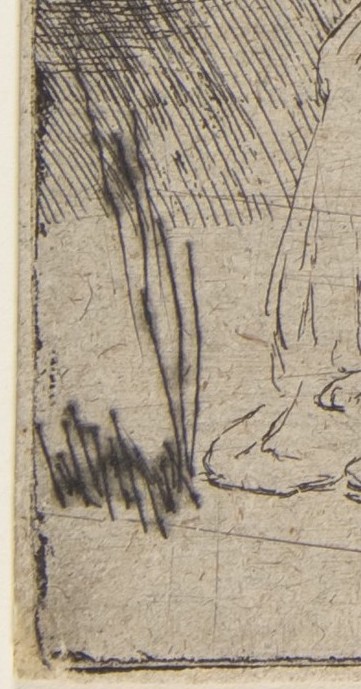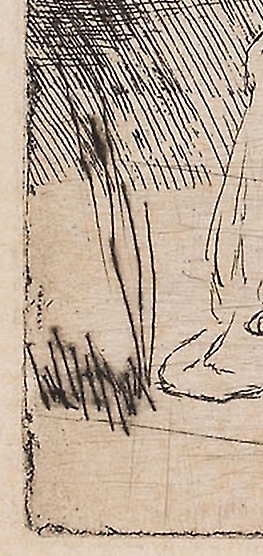Student Paper: Print Matrix Degradation and the use of Damage to Date Prints
- Fenna Engelke
- Dec 19, 2020
- 7 min read
Updated: Jan 4, 2024

I. Introduction
Within the realm of print identification and the dating of printed historic works, there are many methods from which to choose from. Many works before the 19th century are poorly dated and have proven an issue when attempting to give a date to cultural works, like those from Rembrandt or Shakespeare.[1] In the past 30 years, the literature on object dating started to turn from the print to the print matrices in efforts to date these pieces. Print matrices, in this context, refer to the object from which the print is made like the copper plates in intaglio and the wood blocks in relief printing.[2] These print matrices can degrade over time and with continuous use. The creation of new woodblocks and copper plates was historically expensive and so they were often reused for as long as possible to save on cost.[3] This can be seen when comparing initial, early prints with later ones and can be used in print identification when trying to date a print edition. In the course of this paper, I hope to go over common sources of intaglio and relief matrix degradation over time and how they appear in resulting prints. This information can help place prints within a frame of time and give more information to the viewer on the use and number of editions these matrices were often used to create.
II. Existing Literature
A renewal of interest in artist plates as a source for historical clues seems to have started to appear within the 1990s, especially in response to the sale of several Rembrandt copper plates at a London auction in 1993.[4] While interest in print matrices has occurred in centuries prior, much of this interest was focused on techniques of artists, the printability of the matrices [5], or in the effort to categorize the number and quality of an artist’s prints.[6] The main sources used here were written by S. Blair Hedges and were written as examples of how to use this dating method on the intaglio and relief images within reprinted editions. However, this is not a unique method suddenly discovered by Hedges as these techniques had previously been employed in attempts to give a date to various Shakespeare play editions and more.[7] Much of the information here is possible due to these sources however the author has also attempted to find other examples of the use of this method by comparing available imagery from museum catalogs and open sources. Some additional and less method-related source material was used to supplement and give possible answers to subjects that were not expanded on within the original source text of S. Blair Hedges.
III. Intaglio Plates and Degradation
Intaglio copper plates can show several signs of image fading over time with overuse and some of the image degradations are dependent on the intaglio technique used. When an artist uses a drypoint technique, a stylus needle is used to carve a line directly into the copper plate. This causes a buildup of copper along the sides and at the end of the drawn line which is called a burr and can hold ink when it is later printed. The resulting image will have a fuzzy dark area around the line where the burr is left. This is done purposefully for the sake of the image it creates, however, it is also often the first bit of the plate to degrade. Drypoint intaglio prints are often created in short-run editions due to this fact and are often limited to around a dozen prints before the burr degrades under the constant pressures of the printing process.[8] Quality of the copper plate can be a determining factor in the durability of the burr in drypoint techniques. While modern copper plates are rolled, older copper plates from around the 17th century were cold-hammered which could give a stronger copper burr and allow slightly larger editions of up to 50.[9] Even then, this was historically not a technique that lends well to mass production but was often valued for its resulting line quality and for the very fact that it could make small but valuable limited editions. Figure 1 [11] and Figure 2 [12] show two printings of Rembrandt’s St. Jerome Reading in an Italian Landscape and show the comparative drypoint lines on each.
Other, more common techniques used for large print editions, like engraving, etching, and aquatinting, can also show signs of deterioration over time and can often be seen in the resulting prints as lines become thinner and fade in depth of color.[12] Engraved lines, in particular, can vary in their rate of thinning over time as the shape and depth of the carved lines are dependent on the type or shape of the burin used.[13] In the case of etching and aquatinting, the depth and shape of the lines are dependent on how long the plate was left within the mordant and so many lines within an image could potentially all be the same depth and therefore deteriorate at a similar rate if they were created in the same etching session.[14] Generally, engraved lines tend to be deeper than etched lines which are shallower in comparison and so etched lines tend to show more line fading in later printings.[15]
The cause of this fading itself is less due to the pressures of the press, like that seen in drypoint printing, but rather due to the copper of the plate corroding over time and the need to polish the plate before printing when the corrosion occurs.[16] Case studies looking into prints for book editions have found significant support for the relationship between the degradation of the image and the time between edition printings, with case study prints showing a rate of corrosion and material loss of 1.4µm per year.[17] As stated, much of the loss was due to polishing plates before printing to rid the plate of corrosion. Copper objects have a general rate of corrosion which is dependent on several factors including humidity, temperature, and exposure to pollutants. While we cannot be sure of the conditions in which many historic copper plates were kept, we can assume that they were not left outdoors to the elements where the corrosion would be at its worst. A study of corrosion in copper items in museum settings found that, excluding two of the worst testing locations [18], copper degradation could vary between 0-0.054µm/year.[19] Of course, historic items were not displayed in modern-day museum showrooms and so it can be assumed that the corrosion rate of these copper plates was higher than the reported 0.054µm while sitting in the storage rooms of publishing houses. If the corrosion of these objects is already reaching 0.054µm per year in these protected spaces then the amount of corrosion a 17th or 18th-century publisher faced when attempting to print later editions would surely be much higher.
While much of the literature on print matrices focuses on the degradation of copper plates, there is very little given on zinc plates which were discovered as a viable etching method around the 1850s and was introduced more widely into the field around 1862 as an alternative to expensive copper plates.[20] This is a subject matter which would require more case studies and further research for comparison.
IV. Relief Matrices and Degradation
In the case of woodblock relief printing, damage to the print matrix results in broken lines within the imagery. In the process of creating a woodblock print, the block is carved in the negative, with the positive lines of the imagery left uncarved in order to hold the ink. While a more readily available form of printing than intaglio, the wood matrix is subject to many more potential hazards over its lifetime and can result in image damages. The lines on the block, especially when they are thin, are easily broken from manual mistakes. The wood itself can crack and is susceptible to changes in temperature and humidity.
Insects are also a hazard for woodblock matrices. It is very rare to find surviving woodblocks from the 15th century without evidence that they have been eaten away by wood-loving insects. The appearance of wormholes within woodblock prints and the woodblocks themselves are so prevalent in the material that they have given insight into the migration of wood-eating beetles throughout Europe before the 1900s.[21]
Figure 3 and 4 show an example of extreme damage done to a woodblock by insect infestations and how weakened the block becomes. The beetles that eat the wood from the woodblocks lay their larvae within the wood and as the larva mature, they burrow out of the wood, thus leaving the round exit holes seen below.[22]
Insect damages were not just a phenomenon that happened years after the print process was over. Figures 5, 6, and 7 show three prints of Dürer’s Samson Killing the Lion. All are in the collection of the Cleveland Museum of Art, however, an up-close comparison of all three prints shows several areas where holes created by insects have affected the imagery on Figure 6 and Figure 7 of the prints. Even more intriguing, there is a progression in the number of holes present in the images. When comparing the most damaged printed image, Figure 7, to the original woodblock (see Figure 8) we see the same holes in the print present in the block, confirming that they are insect holes and not another kind of damage. With this side-by-side comparison, it is possible to begin a timeline of the wood block using the prints as evidence and we can more confidently date the prints, with Figure 5 being an early print and Figure 7, with the most damages, the latest print.
V. Conclusion
Overall, the use of dating via matrix degradation is one of many available methods for those looking at prints when doing research or placing a historic work within a context of time. It is a method that takes quite a bit of comparative examination and a keen eye which is not always possible but has been used with success in the past. This text sought to outline some of the ways this dating method could be used and how to find the signs of print degradation over time when looking at intaglio and relief prints. The subject of matrices and their degradation is one that could use further research and could be expanded upon, beyond what has been mentioned here. For example, the section on degradation on drypoint line burrs is information known in the field but not mentioned in articles on dating editions and is not addressed as a possible method of dating prints. This paper itself only briefly covers the possibilities of this method and further case studies could be done in the degradation of other printing mediums like that of lithography, wood engravings, or the previously mentioned zinc plate intaglios. The literature on this subject focuses solely on western or European prints and further exploration into how eastern matrices degrade could be relevant. Some techniques like mezzotinting and sugar lifts are also not covered in the scope of the literature found on this subject and could potentially be further investigated in their visual degradation over the course of multiple editions.
This text was written as part of the UvA Book and Paper Conservation and Restoration curriculum requirements in the Fall of 2018.
Footnotes:
Bibliography:
Figures:
























Comentarios